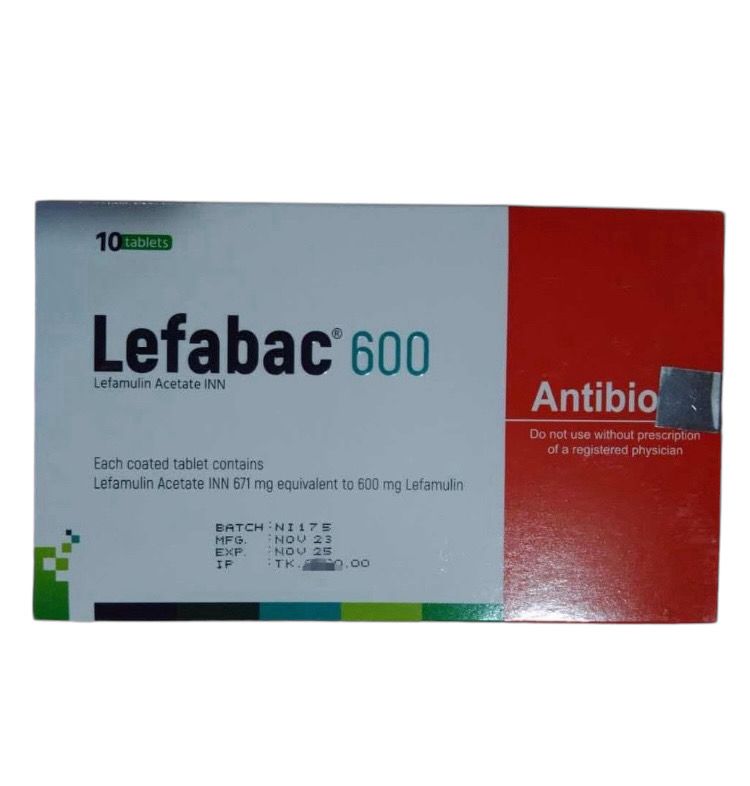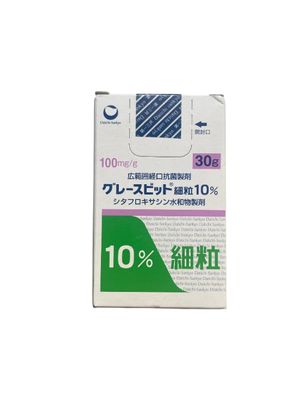Lefamulin (Lefabac) 600 mg 10 tablets
245,00 €
Antibiotic
In stock
Save this product for later
Customer reviews
Reviews only from verified customers
No reviews yet. You can buy this product and be the first to leave a review.
Lefamulin (Lefabac) 600 mg 10 tablets
Product Details
Lefamulin (Lefabak) 600 mg 10 tablets is an antibiotic of the pleuromutin class, which inhibits bacterial protein synthesis by binding to the peptidyltransferase center of the 50S bacterial ribosome subunit, thereby preventing the binding of transport RNA. This drug is a generic (full analog) of the drug Xenlet.
Composition:
Lefamulin Acetate
600 mg
Indication:
Lefamulin is indicated for the treatment of community-acquired bacterial pneumonia (IBD) caused by the following sensitive microorganisms:
Streptococcus pneumoniae
Staphylococcus aureus
Haemophilus influenzae
Legionella pneumophila
Mycoplasma pneumoniae
Chlamydophila pneumoniae
Pharmacology
Lefamulin acetate is a semi—synthetic antibacterial agent for oral and intravenous administration. Lefamulin has a new mechanism of action that is effective against resistant bacteria that cause pneumonia. Lefamulin is a systemic pleuromutin antibacterial drug. It suppresses bacterial protein synthesis through interaction (hydrogen bonds, hydrophobic interactions and Van der Waals forces) with the A- and P-sites of the peptidyltransferase (PTC) center in the V 23s domain of the 50S rRNA subunit.
Method of administration and dosage
Dosage of lefamulin for adult patients with FGM: lefamulin at a dosage of 150 mg every 12 hours as an intravenous infusion for 60 minutes for 5-7 days (with the possibility of switching to lefamulin tablets at a dosage of 600 mg every 12 hours to complete the course of treatment). Lefamulin tablets in a dosage of 600 mg orally every 12 hours for 5 days. For patients with severe hepatic impairment, dose adjustment is required.
Dose adjustment for patients with liver failure
Lefamulin for injection: patients with severe hepatic impairment should reduce the dosage of Lefamulin for injection to 150 mg, administered intravenously for 60 minutes every 24 hours. Patients with mild or moderate hepatic impairment do not need to adjust the dosage of Lefamulin for injection.
Lefamulin Tablets: Lefamulin tablets have not been studied and are not recommended for patients with moderate or severe liver failure. Patients with mild hepatic insufficiency do not need to adjust the dosage of Lefamulin tablets.
Important instructions for use
Lefamulin for injection: Lefamulin for injection is administered intravenously for 60 minutes. Before use, it is necessary to dilute in 250 ml of citrate buffered 0.9% sodium chloride solution for injection, included in the delivery package of Lefamulin for injection.
Lefamulin Tablets: Take Lefamulin tablets at least 1 hour before meals or 2 hours after meals. Do not crush or separate the Lefamulin tablets.
Missed dose: If a dose is missed, the patient should take it as soon as possible, but no later than 8 hours before the next scheduled appointment. If there are less than 8 hours left before the next scheduled appointment, do not take the missed dose and resume taking according to the schedule.
Preparation of an injection of lefamulin for intravenous infusion-
Dilute the entire 15 ml vial of Lefamulin for injection in a vial with a solvent included in the Lefamulin injection kit, which contains 250 ml of citrate buffered 0.9% sodium chloride solution.
When adding Injection Lefamulin to a bottle with a solvent, use an aseptic technique. Mix thoroughly.
Use the diluent bottle only if the solution is clear and the container is not damaged.
Do not use the diluent bottle in serial connections.
Do not add other substances to the solvent bottle, as their compatibility with Lefamulin for injection has not been established.
Contraindication:
The use of lefamulin with CYP3A4 substrates that prolong the QT interval, such as tacrolimus, dofetilide and quetiapine, is contraindicated.
It is also not recommended to use the drug during pregnancy and lactation, as no treatment studies have been conducted in these cases.
Notable side effects:Lefamulin can cause prolongation of the QT interval, especially in combination with other drugs that prolong the QT interval.
Side effects
Lefabak can potentially increase the QT interval. The use of Lefabac should be avoided in patients with known QT prolongation, ventricular arrhythmias and patients receiving drugs that may increase the QT interval. Diarrhea associated with Clostridioides difficile (CDAD) has been reported with the use of almost all systemic antibacterial agents, including Lefabac, with severity ranging from mild diarrhea to fatal colitis.
Pregnancy and lactation
Pregnancy: No clinical studies have been conducted on pregnant women, animal studies have shown that the administration of lefamulin acetate led to an increase in the frequency of stillbirths, malformations were also observed in rats with systemic exposure less than systemic exposure in patients with CAP. Lefamulin IV should be used during pregnancy only if the potential benefit justifies the potential risk to the mother and fetus.
Lactation period: There is no data on the presence of lefamulin acetate in breast milk, its effect on a breastfed baby, or its effect on milk production. Animal studies have shown that lefamulin was concentrated in the milk of lactating rats. Due to the possibility of serious adverse reactions, including prolongation of the QT interval, a woman should express breast milk and refuse it during treatment with Lefamulin IV and within 2 days after taking the last dose.
Precautions and warnings
Cases of Clostridium Difficile-associated disease (CDAD) have been reported with the use of many antibacterial drugs, including Lefabak for intravenous administration. CDAD can occur in varying degrees of severity: from mild diarrhea to death. It is important to consider this diagnosis in patients with diarrhea or symptoms of colitis, pseudomembranous colitis, toxic megacolon or perforation of the colon after taking any antibacterial drug. In some patients, intravenous lefabak may prolong the QT interval on an electrocardiogram (ECG). Avoid using lefabac intravenously in the following patients
Patients with known QT interval prolongation
Patients with ventricular arrhythmias, including acute seizures
Patients taking Class IA antiarrhythmic drugs (e.g. quinidine, procainamide) or Class IIIA (e.g. amiodarone, sotalol)
Patients taking other drugs that prolong the QT interval, such as antipsychotics, erythromycin, pimozide, moxifloxacin and tricyclic antidepressants
The consequences of an overdose
Treatment of an overdose with Lefabak IV should include monitoring and general support measures. It is necessary to empty the stomach, maintain adequate hydration and control the level of electrolytes. Electrocardiogram (ECG) monitoring is recommended. Hemodialysis will not lead to significant removal of Lefabak IV from the systemic circulation
Produced by ACI Limited Bangladesh
Ask a question or inquire about delivery to your country
You May Also Like
Display prices in:EUR

